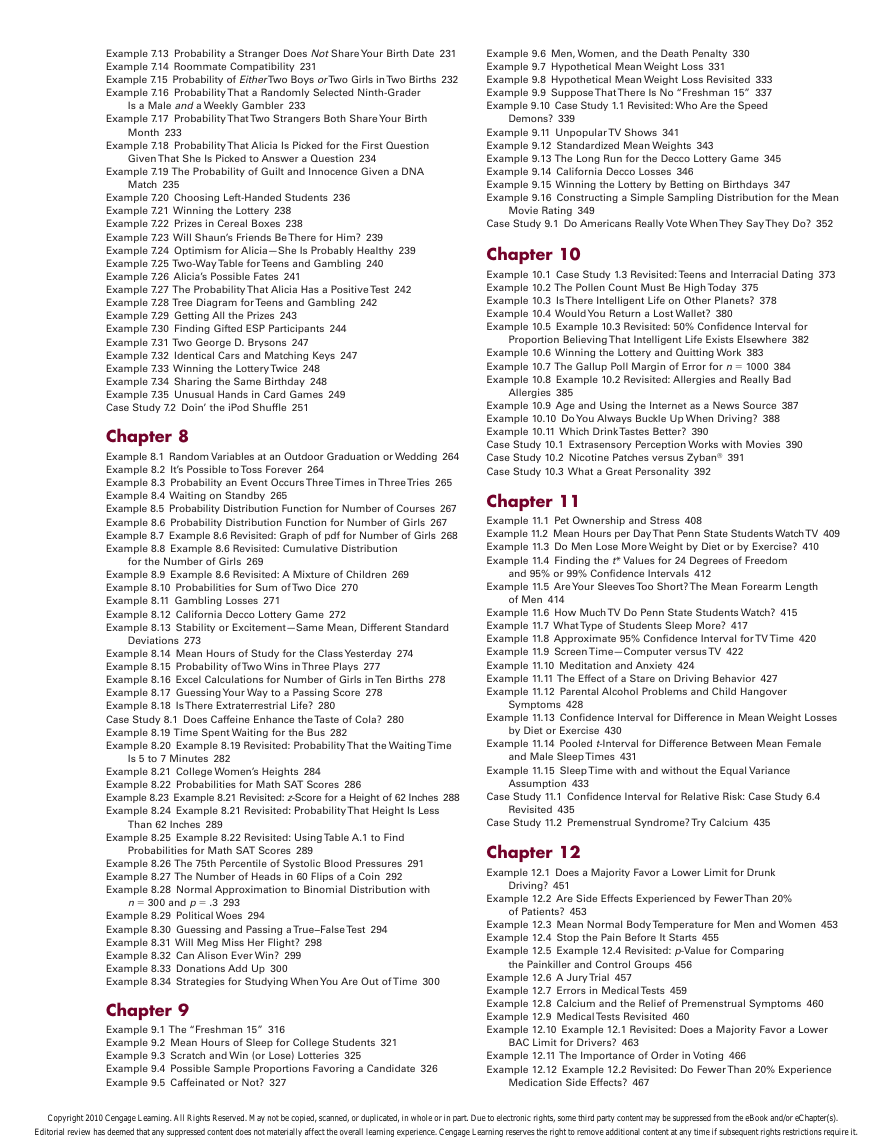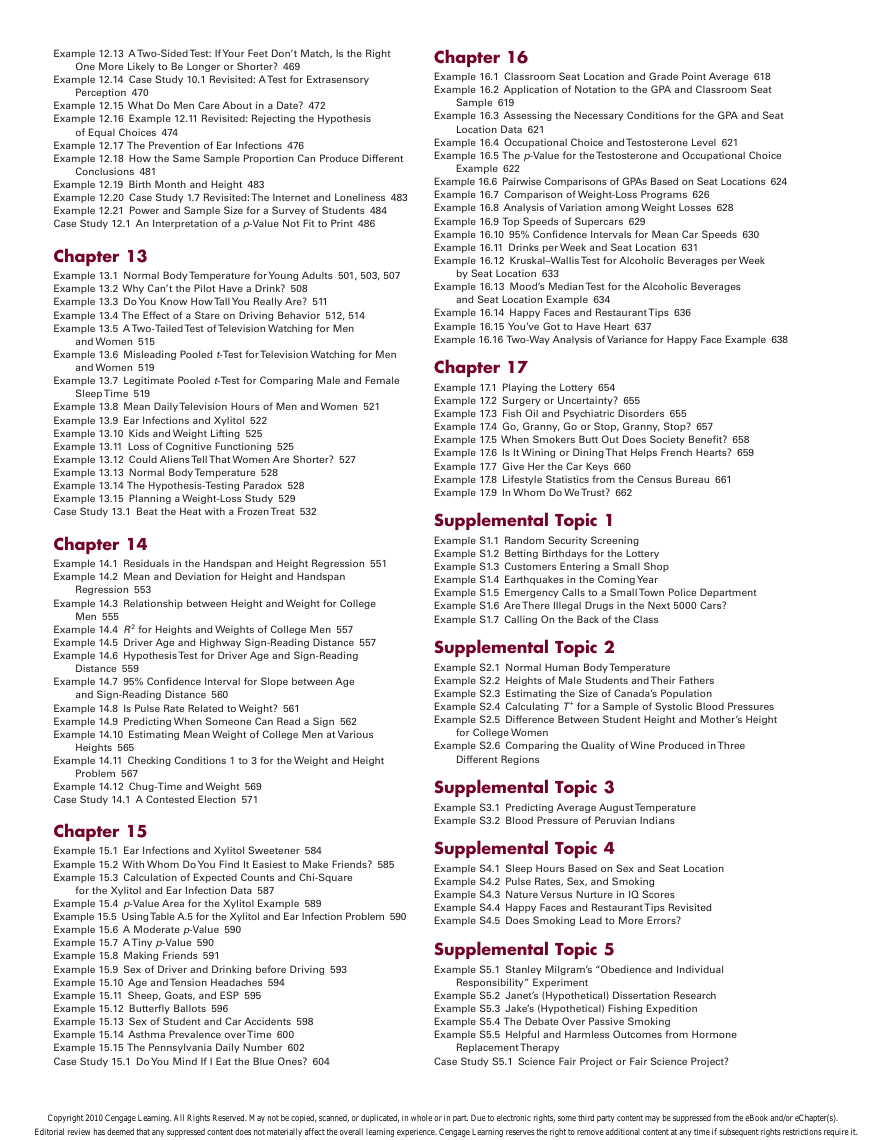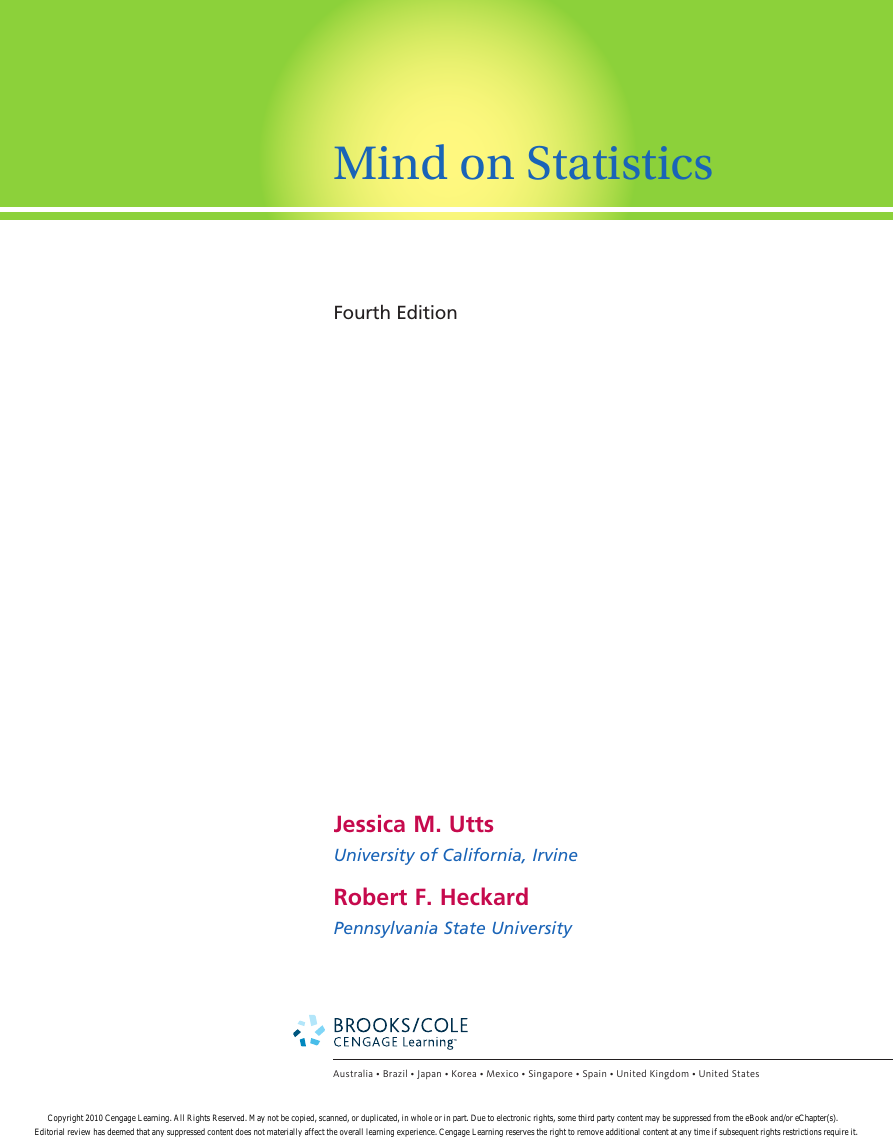Cover Page
Case Studies and Examples
Chapter 1
Chapter 2
Chapter 3
Chapter 4
Chapter 5
Chapter 6
Chapter 7
Chapter 8
Chapter 9
Chapter 10
Chapter 11
Chapter 12
Chapter 13
Chapter 14
Chapter 15
Chapter 16
Chapter 17
Supplemental Topic 1
Supplemental Topic 2
Supplemental Topic 3
Supplemental Topic 4
Supplemental Topic 5
Half-Title Page
Title Page
Copyright Page
Dedication Page
Brief Contents
Contents
Preface
A Challenge
What Is Statistics, and Who Should Care?
How Is This Book Different? Two Basic Premises of Learning
New to This Edition
Text Features
Student Resources: Tools for Learning
Tools for Conceptual Understanding
Investigating Real-Life Questions
Getting Practice
Technology for Developing Concepts and Analyzing Data
Tools for Review
Tools for Active Learning
Instructor Resources: Tools for Assessment
A Note to Instructors
Acknowledgments
Chapter 1: Statistics Success Stories and Cautionary Tales
1.1: What Is Statistics?
1.2: Eight Statistical Stories with Morals
1.3: The Common Elements in the Eight Stories
Key Terms
In Summary box
Exercises
Chapter 2: Turning Data into Information
2.1: Raw Data
2.2: Types of Variables
2.3: Summarizing One or Two Categorical Variables
2.4: Exploring Features of Quantitative Data with Pictures
2.5: Numerical Summaries of Quantitative Variables
2.6: How to Handle Outliers
2.7: Bell-Shaped Distributions and Standard Deviations
2.8: The Empirical Rule in Action
Key Terms
In Summary Boxes
Exercises
Chapter 3: Relationships Between Quantitative Variables
3.1: Looking for Patterns with Scatterplots
3.2: Describing Linear Patterns with a Regression Line
3.3: Measuring Strength and Direction with Correlation
3.4: Regression and Correlation Difficulties and Disasters
3.5: Correlation Does Not Prove Causation
3.6: Exploring Correlation
Key Terms
In Summary Box
Exercises
Chapter 4: Relationships Between Categorical Variables
4.1: Displaying Relationships Between Categorical Variables
4.2: Risk, Relative Risk, and Misleading Statistics about Risk
4.3: The Effect of a Third Variable and Simpson’s Paradox
4.4: Assessing the Statistical Significance of a 2X2 Table
Key Terms
In Summary Boxes
Exercises
Chapter 5: Sampling: Surveys and How to Ask Questions
5.1: Collecting and Using Sample Data Wisely
5.2: Margin of Error, Confidence Intervals, and Sample Size
5.3: Choosing a Simple Random Sample
5.4: Other Sampling Methods
5.5: Difficulties and Disasters in Sampling
5.6: How to Ask Survey Questions
5.7: Random Sampling in Action
Key Terms
In Summary Boxes
Exercises
Chapter 6: Gathering Useful Data for Examining Relationships
6.1: Speaking the Language of Research Studies
6.2: Designing a Good Experiment
6.3: Designing a Good Observational Study
6.4: Difficulties and Disasters in Experiments and Observational Studies
Key Terms
In Summary Boxes
Exercises
Chapter 7: Probability
7.1: Random Circumstances
7.2: Interpretations of Probability
7.3: Probability Definitions and Relationships
7.4: Basic Rules for Finding Probabilities
7.5: Finding Complicated Probabilities
7.6: Using Simulation to Estimate Probabilities
7.7: Flawed Intuitive Judgments about Probability
Key Terms
In Summary Boxes
Exercises
Chapter 8: Random Variables
8.1: What Is a Random Variable?
8.2: Discrete Random Variables
8.3: Expectations for Random Variables
8.4: Binomial Random Variables
8.5: Continuous Random Variables
8.6: Normal Random Variables
8.7: Approximating Binomial Distribution Probabilities
8.8: Sums, Differences, and Combinations of Random Variables
Key Terms
In Summary Boxes
Exercises
Chapter 9: Understanding Sampling Distributions: Statistics as Random Variables
9.1: Parameters, Statistics,and Statistical Inference
9.2: From Curiosity to Questions about Parameters
9.3: SD Module 0: An Overview of Sampling Distributions
9.4: SD Module 1: Sampling Distribution for One Sample Proportion
9.5: SD Module 2: Sampling Distribution for the Difference in Two Sample Proportions
9.6: SD Module 3: Sampling Distribution for One Sample Mean
9.7: SD Module 4: Sampling Distribution for the Sample Mean of Paired Differences
9.8: SD Module 5: Sampling Distribution for the Difference in Two Sample Means
9.9: Preparing for Statistical Inference: Standardized Statistics
9.10: Generalizations beyond the Big Five
9.11: Finding the Pattern in Sample Means
Key Terms
In Summary Boxes
Exercises
Chapter 10: Estimating Proportions with Confidence
10.1: CI Module 0: An Overview of Confidence Intervals
10.2: CI Module 1: Confidence Interval for a Population Proportion
10.3: CI Module 2: Confidence Intervals for the Difference in Two Population Proportions
10.4: Using Confidence Intervals to Guide Decisions
Key Terms
In Summary Boxes
Exercises
Chapter 11: Estimating Means with Confidence
11.1: Introduction to Confidence Intervals for Means
11.2: CI Module 3: Confidence Intervals for One Population Mean
11.3: CI Module 4: Confidence Interval for the Population Mean of Paired Differences
11.4: CI Module 5: Confidence Interval for the Difference in Two Population Means (Independent Samples)
11.5: Understanding Any Confidence Interval
11.6: The Confidence Level in Action
Key Terms
In Summary Boxes
Exercises
Chapter 12: Testing Hypotheses about Proportions
12.1: HT Module 0: An Overview of Hypothesis Testing
12.2: HT Module 1: Testing Hypotheses about a Population Proportion
12.3: HT Module 2: Testing Hypotheses about the Difference in Two Population Proportions
12.4: Sample Size, Statistical Significance, and Practical Importance
Key Terms
In Summary Boxes
Exercises
Chapter 13: Testing Hypotheses about Means
13.1: Introduction to Hypothesis Tests for Means
13.2: HT Module 3: Testing Hypotheses about One Population Mean
13.3: HT Module 4: Testing Hypotheses about the Population Mean of Paired Differences
13.4: HT Module 5: Testing Hypotheses about the Difference in Two Population Means (Independent Samples)
13.5: The Relationship Between Significance Tests and Confidence Intervals
13.6: Choosing an Appropriate Inference Procedure
13.7: Effect Size
13.8: Evaluating Significance in Research Reports
Key Terms
In Summary Boxes
Exercises
Chapter 14: Inference about Simple Regression
14.1: Sample and Population Regression Models
14.2: Estimating the Standard Deviation for Regression
14.3: Inference about the Slope of a Linear Regression
14.4: Predicting y and Estimating Mean y at a Specific x
14.5: Checking Conditions for Using Regression Models for Inference
Key Terms
In Summary Boxes
Exercises
Chapter 15: More about Inference for Categorical Variables
15.1: The Chi-Square Test for Two-Way Tables
15.2: Analyzing 2X2 Tables
15.3: Testing Hypotheses about One Categorical Variable: Goodness of Fit
Key Terms
In Summary Boxes
Exercises
Chapter 16: Analysis of Variance
16.1: Comparing Means with an ANOVA F-Test
16.2: Details of One-Way Analysis of Variance
16.3: Other Methods for Comparing Populations
16.4: Two-Way Analysis of Variance
Key Terms
In Summary Boxes
Exercises
Chapter 17: Turning Information into Wisdom
17.1: Beyond the Data
17.2: Transforming Uncertainty into Wisdom
17.3: Making Personal Decisions
17.4: Control of Societal Risks
17.5: Understanding Our World
17.6: Getting to Know You
17.7: Words to the Wise
In Summary Boxes
Exercises
Appendix of Tables
References
Answers to Selected Odd-Numbered Exercises
Chapter 1
Chapter 2
Chapter 3
Chapter 4
Chapter 5
Chapter 6
Chapter 7
Chapter 8
Chapter 9
Chapter 10
Chapter 11
Chapter 12
Chapter 13
Chapter 14
Chapter 15
Chapter 16
Chapter 17
Text Credits
Index
A
B
C
D
E
F
G
H
I
J
K
L
M
N
O
P
Q
R
R
S
T
U
V
W
X
Y
Z
















 2023年江西萍乡中考道德与法治真题及答案.doc
2023年江西萍乡中考道德与法治真题及答案.doc 2012年重庆南川中考生物真题及答案.doc
2012年重庆南川中考生物真题及答案.doc 2013年江西师范大学地理学综合及文艺理论基础考研真题.doc
2013年江西师范大学地理学综合及文艺理论基础考研真题.doc 2020年四川甘孜小升初语文真题及答案I卷.doc
2020年四川甘孜小升初语文真题及答案I卷.doc 2020年注册岩土工程师专业基础考试真题及答案.doc
2020年注册岩土工程师专业基础考试真题及答案.doc 2023-2024学年福建省厦门市九年级上学期数学月考试题及答案.doc
2023-2024学年福建省厦门市九年级上学期数学月考试题及答案.doc 2021-2022学年辽宁省沈阳市大东区九年级上学期语文期末试题及答案.doc
2021-2022学年辽宁省沈阳市大东区九年级上学期语文期末试题及答案.doc 2022-2023学年北京东城区初三第一学期物理期末试卷及答案.doc
2022-2023学年北京东城区初三第一学期物理期末试卷及答案.doc 2018上半年江西教师资格初中地理学科知识与教学能力真题及答案.doc
2018上半年江西教师资格初中地理学科知识与教学能力真题及答案.doc 2012年河北国家公务员申论考试真题及答案-省级.doc
2012年河北国家公务员申论考试真题及答案-省级.doc 2020-2021学年江苏省扬州市江都区邵樊片九年级上学期数学第一次质量检测试题及答案.doc
2020-2021学年江苏省扬州市江都区邵樊片九年级上学期数学第一次质量检测试题及答案.doc 2022下半年黑龙江教师资格证中学综合素质真题及答案.doc
2022下半年黑龙江教师资格证中学综合素质真题及答案.doc